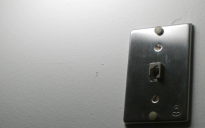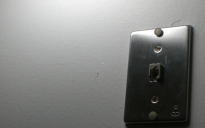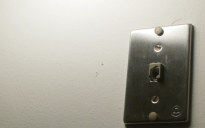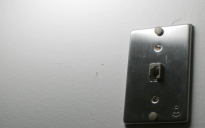
Please, support PV!
It allows to keep PV going, with more focus towards AI, but keeping be one of the few truly independent places.
It allows to keep PV going, with more focus towards AI, but keeping be one of the few truly independent places.
Filmmode Settings Tests: detail handling, color shift, exposure, etc.
-
There's been a lot of discussion about which film mode setting is "best." Usually these discussions are a mix of personal opinion coupled with claims about what setting appears to the perceiver to have more dynamic range. I want to discuss the differences between film modes in a more objective way.
So here's one thread to start that. If you look at the pictures attached, there are four blown up frame grabs (from video, not still). They are: Standard, Cinema, Nostalgic, and Smooth. These all have the same white balance setting, shot with same lens, aperature, shutter speed, and lighting (a practical floor lamp). The picture profile settings are at 0 for everything except sharpening which is -2. This is pre-hack.
There are few noticeable things.
One thing in particular stood out to me, which I don't think people talk about. Look at how highlight and midtone *DETAIL* is handled on mode.
1. Cinema captures more highlight detail than the other settings--the wall on cinema has detail that was actually there, whereas in the other modes there are patches of white mixed with wall detail. These patches aren't blown out highlights!
2. At the same time Cinema captures midtone detail pretty poorly relative to the others. To see this, on the phone jack panel to the left of the phone jack. There are smears there in nostalgic especially that were present, but that cinema doesn't capture.
3. Nostaligic also has a pretty bad color shit to yellow (with a touch of shift to red) as you can confirm by a waveform.
4. Finally, it's worth noting that to achieve comparable exposures in each profile, one might need to allow for a bit more light in cinema and a bit less light in nostalgic.
Thoughts?
I've also been curious about what @cbrandin has been up to with his film mode research (or whether that's petered out).
EDIT: color shit = color shift :p
 standard_01.png1920 x 1200 - 1M
standard_01.png1920 x 1200 - 1M
 cinema_01.png1920 x 1200 - 2M
cinema_01.png1920 x 1200 - 2M
 nostalgic_01.png1920 x 1200 - 2M
nostalgic_01.png1920 x 1200 - 2M
 smooth_01.png1920 x 1200 - 1M
smooth_01.png1920 x 1200 - 1M -
I've used i.dynamic a lot recently and my opinion is that it is complete not worth. It's true that the dark areas are more detailed and visible, but the noise is ugly, colors are worst because if you grade you can see the low res 4:2:0 coming out strongly. Pay attention using i.dynamic
-
@nomad
Thanks for replying.
Problem is I can't get the exposure I want with the aimed look unless I use high ISO.
So, in one side of the balance I have a noisy(MCU Block specifically) but graded image and in the other side I have acceptable noise on shades and image still waiting too be adjusted regarding blacks and contrast.
So Neatvideo or the prores 422 ability to be pushed on grading? -
Try to get contrast, color (or no color in your case) and exposure as close to your final look as you can, but turn down sharpness and noise reduction. If you record with high bitrates (preferably GOP1), you have much better chances to get the noise under control in post (Neatvideo). If you don't even like it right away – it will look much more organic, more like film-grain. Very nice if you want a Tri-X look.
-
I wonder if anyone has already carried tests, or simply knows whether it would be better shooting with a suposedly neutral film mode and settings, say smotth -2-2 0 -2 , or just trying to achieve the final look in camera settings. I have read and heard opinions leaning to both sides..
I am shooting dark BW with high contrast. Closest I found on camera was dynamic BW - but getting some nasty noise in some scenes I have been shooting on low light and high iso due to bad exposure this film mode provides. Does anyone has any experience or thoughts to share? thanks -
It's not *much more* difficult. Also, see my comment at the end of the last page, which I fear is now getting buried. The underlying basic point is that important as dynamic range is, that's not the sole consideration in the selection of filmmodes--which is what this thread is about. Since all the filmmodes have more or less the same amount of range, the amount of DR shouldn't be the sole criterion for selecting a mode. What matters for selecting a mode is how it handles various parts of the image.
I made the basic argument for cinema mode as follows: cinema captures the most detail in the midtones; the midtones are in most scenarios the most important part of the image we want to capture (where skin tones lie); cinema does crush blacks, but, especially with the hack, the blacks can be brought back up. (The argument is more extensive on the previous page.) -
Looking at this post http://www.personal-view.com/talks/discussion/1110/idynamic-range-possible-to-hack#Item_77 where you have the road in the forest, see how the idynamic version is much better because you can see the woods and the sky is not blown out and a good example of a wide shot that is near impossible to lit. For a darker tone, you can if you want just contrast it in post in you want to, but the contrary is much more difficult.
-
where one can use some reflectors, the other one will have to bring some hmi and even a truck. In the case of outdoor shoot with some wide shots, big windows etc. just some cases where a wide Dr camera will make a huge difference. If you can shoot only in a studio just fine, but once you are faced with less controlled lighting which more the case of someone using a GH2 than an Alexa or red.
-
More latitude is always better, but if you're in control of your set, you should be working to control light ratios and required latitude for the shot. Wildlife work is another story, but for most pro work, you can easily work with 9-10 stops of latitude. Blown out window? Gel the dang thing! Use your tools, camera is just one piece of the puzzle.
-
I think that the most noticeable factor in iq in the test of the alexa, f3 and 7d is the amount of color informations. Alexa is far superior than f3 and the 7d is completely out of the games. I could tolerate alexa-like pictures with a blown sky, but not 7d-like pictures with everything in latitude.
Obviously i'd like s-logs for the gh2 because of the latidude, but mostly for color informations. And i'd like even more 4:2:2 10 bit :P -
I've done some tests, and I want to make a case for Cinema Mode (not in all circumstances of course) and will be curious about others responses.
On Dynamic Range Disadvantages (and Advantages?):
*Highlights Exposure: It is true that Cinema exposes about 1/3 of a stop less than Nostalgic (according to the DPreview), and gets about the same highlight exposure as Standard and Smooth.
**Shadows Exposure: It's also true that Cinema exposes a full stop less into the shadows than Nostalgic, and 2/3 of stop less than Standard or Smooth.
**Roll-Off: The highlight and shadow roll-off of cinema seems worse than Nostalgic on the DPreviewcharts, but... I'd like to look at some waveforms.
Than how could one possibly make the case for Cinema? Well:
(1) The most important of the luminance spectrum for most shots anyone will want to take will be the midtones. That's usually where faces are exposed (just above, at, or below medium gray). Thus, it is in general desirable to have more detail and information in the midtones. And Cinema seems to have just that! Look again at the DPreview site: midtone range of cinema is largest. It also seems to better represent color. And:
(2) At the same exposure settings, highlights in cinema are just as well protected if not better than other modes (including Nostalgic). It's just that the blacks will be crushed sooner. BUT: thanks to the Hack, blacks are more easily retrievable in post. Once your highlights go in video, you can't get that detail back. But you CAN get the shadows in Cinema to be just like those in Nostalgic with some post work (especially a greater separation between the shadows and midtones).
(3) Cinema also appears to have LESS NOISE than the other modes (even though it's technically under-exposing relative to other modes at the same f-stop, shutter, ISO).
Also, Standard mode is actually a nice compromise between the advantages of cinema and smooth. But its midtone range is not as good as cinema.
As for Personal taste: to me, the color shi(f)t of Nostalgic is unbearable (although I could maybe see how certain situations would be amenable to them ala LPowell's suggestion); the skintones in smooth and dynamic are respectively too destaturated and too saturated. Dynamic seems nice on some color charts, but it makes people's faces look like they've had too much carrot juice!!
By the way, I just realized after a search (doh!) that there was a nice thread on filmmodes earlier, and if @Vitaliy wants to merge this over to that one, he should. -
What I am saying is that for me, we have reached a level in sharpness and motion with the hack that we should concentrate on the Dynamic range of the sensor for it to really bring any progress for film-making. The example above really show how dynamic range is important in a practical way. Gelling the window or lighting a subject where sunlight is concern needs a lot of time or very powerful lighting.
Many just think about sharpness because it is easily seen or quantified. But for production value dynamic Range is as important if not more than sharpness. We are not going to get f3 or Alexa DR, but the more we can get the better. Hoping that VK can get some flat film mode or hack the i-dynamic. -
I'd love a tonne of DR, but in reality, with a very limited budget, the DR of the GH2 and its competitors will have to be fine.Bang for buck, very little can compete. Any extra DR we can squeeze out of the GH2 is fine by me.
I'm having good results with nostalgic with a tweak in the WB fine tuning, and that's in daylight too. I've plenty of testing left to do though, which will take time. The WB fine tuning is a god send though. -
Or use some ND window gels: http://www.filmtools.com/31-lee-r299.html
-
This is a interesting comparison between the DR of the Alexa, F3/slog and a 60D . It really shows the advantage of having much more DR, more so for indie shooters because it simplifies the lighting process. Look at the last example (the interior one) with the two girls inside with a window behind them. The Alexa and F3 maintain detail in both the actors and the background. For the 60D looses detail in the outside shot. The building the left is a good example where you see only the contour of the windows and the walls have blown out completely. With the 60D you would have to either gel the window or light the actors (or both) to reach the level of exposure that is capable with the F3 and Alexa.
The result would be that it will cost you both in time or Money to have the same scene with a lesser DR camera. In most cases it would require only an S-curve in post for the high DR shots. This is why I would a 1000 times prefer a 2k 14 stop DR camera to a 4K 12.5 one. -
if you whitebalance in post your just asking for problems, the best thing you can do on a shoot with an 8bit 4:2:0 camera is get your COLORS and EXPOSURE in camera...
-
This is the reason they call it nostalgic. It's a bit on the yellow warm side.
Leave it as is and white balance in post, then create whatever look you want.
-
wow I never noticed the yellow shift in nostalgic mode, thats no bueno I wonder if it can be corrected via WB before shooting
-
I'm not saying I wouldn't love more DR, even two more stops would be great.
There are a ton of "films" shot on video with poor dynamic range that have been great. You yourself can do a little search to find that out.
A good DP will know a cameras limitations and work around them. Even in outdoor situations, the biggest problems you'll come across with the GH2 is shooting someone in the shadows while there is also a very bright sky in the frame. There are alternative solutions to this apart from more DR: add light; add a graduated filter; don't shoot the person in the shadow; or split the difference in exposure.
Again, I'd love more DR and I think it should be a priority if there's a chance to achieve it. -
-
I fully agree on this. Once we have 100 % stable patch with good quality the next most important things is DR. Lets hope its hackable.
-
I find it a bit too simplistic to say " hey, one film out of ten was shot on film stock with low latitude so we don't need more than 9 stop". You are forgetting the 9 others, in fact if you have to search so much to find one, the proportion could be even lower. I am sure that for artistic choices someone can shoot with a low latitude and or high contrast. Another example if you are doing a film in a very cloudy low contrast and rainy weather/style then you won't need that much. But if in the contrary you have high contrast lighting, mainly outside when it is much more difficult to control the lighting, then the DR becomes vital. There is nothing more disturbing that big patches of blow out white, more so in a cinema because of the dark room.
Dynamic Range is even more important for the indie type of shooter. Now lets take a simple and practical example where DR would make a huge difference. You are in a room and you have a window. If you expose for your actor inside the windows blows out completely and if you expose for the window the actor will be a silhouette. depending on the ratio of stops/contrast between the outside and inside, where your 9 stops camera will require you to gel the windows and light the subject, a camera like the Alexa could capture it as is because of its 14 stop DR. In more extreme case you might need to just gel the window or just light the subject. But not both, or to a lesser degree, that is a Kino might be enough compared to an HMI. With grading software like Davinci you can have selective exposure with the mask and tracker, if the info is their you can for example expose for the window and relight your actor in post. That is just boost the exposure on the actor so as not loosing detail in the window.
This is why a camera like the Alexa is so highly rated. On paper spec the RED should have completely taken the market, but it is the DR of this camera which makes it the closest to film. For me, the hacked gh2 is sharp enough, getting the most DR should be the priority now and the idynamic seems perhaps the best bet to extract the most out of it. I am not saying that we will get Alexa DR, but the more the better. The gh2 is rated at 11.5 - 12stops in RAW, if we could approach that it would be nice. -
Thanks for the info! We still have out non-reflex bolex, by the way... haven't rolled any film through it though since the last spaceship one launch (we also shot super 8 kodachrome at that event).
-
Neither do all film stocks have the same latitude nor do they all have wide latitude.
B&W 16mm Tri-X Reversal 7266 is an example: I think it only has about 5 stops (maybe 6)! (still made today by the way) Other things equal, reversal stocks have poorer latitude than negative.
Pi by Darren Aarronfsky was shot on Eastman Plus-X 7276, Tri-X 7278, which also has relatively narrow latitude. It was apparently also shot with a Bolex H-16!
It's actually quite hard to get information about film latitudes on the web through a simple search (I found).
So, full confession: I didn't actually have a film in mind. But I wouldn't be surprised that there are great films with poor latitude film stock used. Citizen Kane, for example, was shot on Super Double-X... and I wouldn't be shocked if that has around 9 stops latitude, etc.
Bottom line: 9.5 stops is enough... -
"Also remember that many great films were shot on stocks with poor latitude relative to what we have today." Can you elaborate? I didn't know that... have always thought of film, even chromes, as having more DR.
-
Dynamic range is certainly something it'd be nice to have a bit more of on the GH2, but I think people sometimes loose sight of the costs of shooting a very flat image: other things equal, there's going to be more post production required. Also remember that many great films were shot on stocks with poor latitude relative to what we have today. .... The primary reason I want a little bit more dynamic range on the gh2 is to help with give it a more smoother highlight roll-off.
Also the discussion started out as filmmode, but given that the dynamic range for each mode is more or less the same, I think it's more fruitful to talk about other characteristics of filmmode: color reproduction, detail reproduction, skin tones (especially), etc...
One of the main things I'm curious about is how each mode handles skin tones... can anyone do some tests about that?
Start New Topic


Howdy, Stranger!
It looks like you're new here. If you want to get involved, click one of these buttons!
Categories
- Topics List23,991
- Blog5,725
- General and News1,354
- Hacks and Patches1,153
- ↳ Top Settings33
- ↳ Beginners256
- ↳ Archives402
- ↳ Hacks News and Development56
- Cameras2,367
- ↳ Panasonic995
- ↳ Canon118
- ↳ Sony156
- ↳ Nikon96
- ↳ Pentax and Samsung70
- ↳ Olympus and Fujifilm101
- ↳ Compacts and Camcorders300
- ↳ Smartphones for video97
- ↳ Pro Video Cameras191
- ↳ BlackMagic and other raw cameras116
- Skill1,960
- ↳ Business and distribution66
- ↳ Preparation, scripts and legal38
- ↳ Art149
- ↳ Import, Convert, Exporting291
- ↳ Editors191
- ↳ Effects and stunts115
- ↳ Color grading197
- ↳ Sound and Music280
- ↳ Lighting96
- ↳ Software and storage tips266
- Gear5,420
- ↳ Filters, Adapters, Matte boxes344
- ↳ Lenses1,582
- ↳ Follow focus and gears93
- ↳ Sound499
- ↳ Lighting gear314
- ↳ Camera movement230
- ↳ Gimbals and copters302
- ↳ Rigs and related stuff273
- ↳ Power solutions83
- ↳ Monitors and viewfinders340
- ↳ Tripods and fluid heads139
- ↳ Storage286
- ↳ Computers and studio gear560
- ↳ VR and 3D248
- Showcase1,859
- Marketplace2,834
- Offtopic1,319






